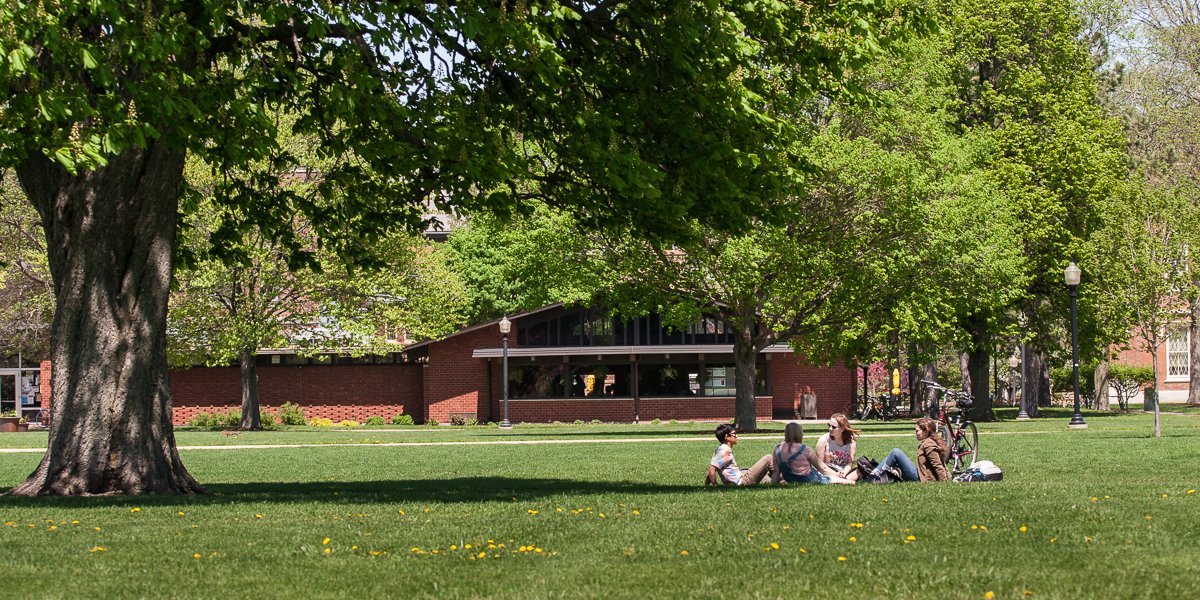



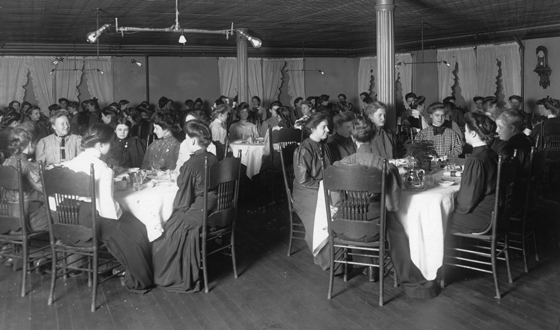
Pictured: Students in the dining room of Whiting Hall, originally established as an all-women's dormitory. |
Though women have long been part of the educational mission of Knox College, the nature and design of women's education have changed significantly since the College's inception. Contemporary social standards had a significant influence on the philosophy of women's education at Knox, and it was not until 1870 that trends towards co-education and student antagonism towards separate education
compelled the integration of separate women's courses into the regular College.
Knox College's Female Seminary was the product of a long tradition of female seminaries designed to address the significant lack of opportunities for advanced education for women during the 18th and 19th century. Until 1833, when Oberlin College was founded as co-educational, there were no colleges in North America that admitted women, making it necessary for entrepreneurs and advocates of women's education to organize their own institutions of higher learning. Many seminaries thus began as small women's boarding schools that expanded to include more advanced curricula, larger classes, and larger faculties. During the first couple decades of the 19th century, female seminaries had begun appearing throughout the American landscape, especially in the East, establishing them as the primary means of higher education for women.
Female seminaries largely had one mutual goal: to prepare women for life as increasingly competent housewives, mothers, and teachers in the public schools. In many cases, as it was with Knox, religious and moral education supplemented this primary objective, as it was felt that an education in morality would have a positive influence on maternity and women's popularly understood profession, teaching.
Early 19th century women's education did not immediately expand women's cultural, social, or vocational opportunities. The expansion of Female Seminaries was primarily a response to the prevailing social standards of the era, but they did not, as evidenced by their goals, have a significant effect on women's position in society as it was then defined. In fact, in contrast to the burgeoning women's right movement of the 1840s -- which demanded greater equity in women's social standing respective to men -- many prominent proponents of women's education maintained the orthodox view of women's role in society during that period, contesting the agenda of the women's rights convention at Seneca Falls and even reaffirming views of woman's traditional "profession."
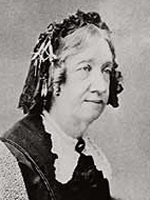
Beecher |
A leading figure in the women's education movement, Catherine Beecher, censured women's rights advocates in a series of articles, including one entitled, "Woman's Profession Dishonored," where she sought to reclaim the sanctity of, as biographer Mae Harveson terms it, "woman's true place and work." Emma Willard, another prominent women's education advocate, supported the education of women to "improve their faculties," but would "not be understood to insinuate that [women] are not in particular situations to yield obedience to the other sex."
Social standards for women, which were tacitly accepted by many in society -- including women -- served to differentiate between the distinct purposes of men's and women's education. Beecher illustrated this in a speech she gave before the Society for the Advancement of Education in 1856, in which she summarized the attitude of the American Women's Educational Association on the utility of women's education, "Give us institutions that shall prepare us for our own distinctive profession, and give us honorable and remunerative employment in it."
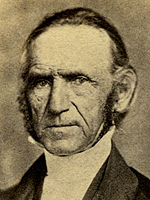 |
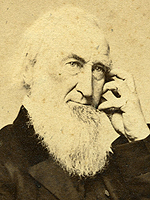 |
|
George Washington Gale, left, and Hiram Kellogg |
|
Similar conceptions of women's social roles and education are present in the philosophies of several early members of the Knox College administration and faculty towards women's education. In his Circular and Plan for the College, founder George Washington Gale defined his intentions for women's education at Knox in terms of their perceived social role:
"It is beginning to be believed, and not without good reason, that women are to act a much more important part in the conversion of the world than has been previously supposed; not as preachers of the gospel, but as help-meets of those who are, and as instructors and guides of the rising generation, not only in the nursery, but in the public school."
Upon entering office in 1841 as Knox College's first president, Hiram Kellogg, who had previously directed a female seminary in New York, likewise addressed the differences between women and men's education:
"Under the influence of the Gospel a different station is allotted to her, she is regarded man's equal in worth; and although her cares, labors and responsibilities, to a considerable extent, be in a different direction, yet they are no less honorable, and require no less of intellectual and moral culture than his."
Both Gale and Kellogg indicate, whether explicitly in Gale's case or implicitly in Kellogg's, that the purpose of women's education, though of equal importance to men's, was fundamentally different based upon their respective social roles.
Professor Innes Grant, one of the College's earliest faculty members, articulated this difference between the nature of men and women in greater detail in a lecture on education before the Lyceum Association in 1852, three years after the incorporation of the female seminary. A woman, Grant said, was the "life giver, and protector of the weak," as opposed to man, who was the "destroyer of life and the defender of the oppressed." Grant argued that the educational courses for men and women, respectively, should serve to foster the development of these characters.
Separate social standards for men and women contributed to the perception that men's and women's education had separate purposes. When Knox College incorporated a college program for women in 1848, it was based upon the programs of other female seminaries and therein upon a tradition of separate education.
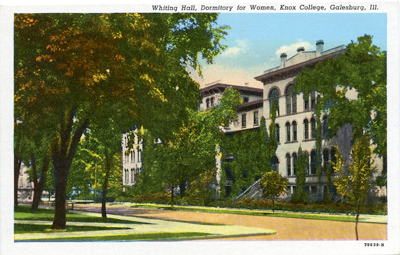
Tinted postcard of the Whiting Hall women's dormitory (undated) |
Women's education was intended to be a component of Knox College from its very beginning in 1841, but fiscal restrictions delayed plans for an advanced female course of study at the College's outset. When the means for a women's course were finally realized, seven years after the College's first class of men had entered, courses were initially held in the new Academy building that had been built for the College's preparatory students (due to a lack of sufficient public education, the College maintained a preparatory school for younger students, male and female, seeking admission to the College courses).
It was not until 1856 that the College's finances finally allowed for the construction of separate housing for the seminary students. This new building was built on Tompkins Street between Cedar and Cherry streets and was aptly named the Female Seminary. Later known to generations of Knox students as Whiting Hall, it still stands in this same location. The first class of the Female Collegiate Department matriculated 14 women, but by the next year the course doubled in size and by the later part of the decade of the 1850s this number would balloon to approximately 60 students in any given year. Throughout, the Seminary housed about as many students as the regular College course. The vast majority of the matriculating students graduated from the Knox Academy and resided in Galesburg. Other students travelled from elsewhere in Illinois or the Midwest to attend the Seminary. There was also a small minority of students from other states, including the East Coast, and one student who attended from as far away as San Francisco, California.
The Female Seminary's curriculum was organized "embracing such branches as are usually pursued in the higher female seminary." The course was set at three years in length and was initially very different in its academic focus than the men's course; the men's course had a strong focus on the classics while the women's course primarily featured science and mathematics classes. In the men's course, Sallust, Xenophon, Cicero, and Euclid were featured. The women, on the other hand, studied subjects like Geology, Chemistry and Botany, Physiology, English Grammar and Algebra. According to educational historian Kim Tolley, classics courses were "the prerogative of middle-class males"; designed to instill rigor in the men's programs, they were deemed unsuitable for women. It was thought that the sciences had a more practical application and could provide the desired rigor for women in place of the classics.
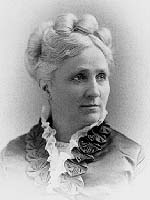
Howard |
The curriculum of the Female Seminary changed only slightly during the decade of the 1850s, expanding in the mid 1860s to become more comparable with the men's program.
In 1867, the Knox College's Board of Trustees and President Harvey Curtis planned to elevate the course of instruction of the Female Seminary and "give wholesome variety to it," so as to "henceforth recognize [sic] in it a true daughter of Mount Holyoke not only in its teachers but in its course of instruction." The College called on Miss Lydia Howard, a graduate and prior faculty member at Mount Holyoke, to develop the expanded course. In the subsequent year's advertisement for the Female Seminary the course of study had been lengthened to four years, and boasted of having "adopted substantially the four years course of Mount Holyoke."
Howard became a reforming force within the Seminary as its principal, a role that brought her into conflict with then-President Curtis. Curtis was a strong proponent of separate education and had restricted the mingling of male and female students even further than had previously been the case, ending a recent practice that had allowed women to take certain courses with their male peers. Curtis believed that a woman's role was in the home and that "she would be ‘out of place in the pulpit or legislative halls." Understandably, he was disliked by the female students, and his philosophy of separate education had been under attack by the student body as a whole for some time.
The Ladies Mutual Improvement literary society, founded in 1861 by women in the Female Seminary, had debated equality in women's education since the middle of the decade in their oratory exercises, with topics such as whether or not "the mind of a woman is more inferior to that of men." College historian Hermann Muelder attributed the debate over the design of women's education at Knox to a trend towards co-education that had become prevalent in the Midwest: Lombard had transitioned to admit women, as had Monmouth College, the University of Wisconsin, and the University of Michigan by the 1860s.
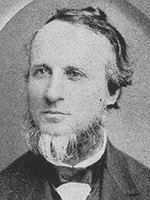
Curtis |
On Friday, March 20, 1867, the debate came to a head. President Curtis and Principal Howard were engaged in an argument over the programming for the next year's catalogue for the Seminary when President Curtis forcibly took the catalogue from Miss Howard's hands in an act of physical violence. When word of Curtis' behavior reached the students the fallout was immediate. The following Saturday morning the students, who largely disliked President Curtis but admired Principal Howard, turned out in numbers on the lawn of Old Main, ringing the building's bell and causing a commotion. From one eyewitness account, "20 or 30 of the College and Academy students ... had cut the rope of the bell [in Old Main] and were turning it over and over," in protest. The students organized a sit-down strike on the lawn, staying away from classes that following Monday and Tuesday, and demanding President Curtis's resignation. Late on Tuesday, the Board of Trustees acquiesced to the students' demands, and asked for Curtis's recognition.
As part of the controversy, Howard tendered her resignation as well, leaving the Board of Trustees with questions about the future of the Female Seminary at Knox. A Trustee "Committee on Seminary" reported that their actions in hiring Miss Howard to revamp the Seminary's curricula had been "a new and somewhat hazardous experiment." The Committee recommended changes in the oversight of the Seminary, saying that the interests of the Seminary should be decided upon by the Seminary faculty.
The actions of President Curtis and Principal Howard had focused attention on the Female Seminary, and in the 1869 catalogue it was reported that growing interest in women's education had prompted the Board of Trustees to consider a plan of co-education. The catalogue further called it "a happy day ... when the brief, irregular, superficial, and too often contemptible style of female education shall give way to a culture which shall furnish the same facilities for success in life ... now accorded to men." By the next year, 1870, the Board of Trustees took the final step of merging the men's and women's courses and awarding women Bachelor's degrees for the first time. Although the Female Seminary would remain open to accommodate women who did not desire a degree, women who were adequately prepared could follow the same coursework as their male counterparts.
The controversy that prompted the integration of the men's and women's courses at Knox was repeated elsewhere in the Midwest during the 1860s as well. At the University of Michigan, women began sitting in on classes without having being admitted, much to the consternation of officials at that school. At the University of Wisconsin, it was initially reported that "the admission of women would let down the standard of culture if it did not destroy the character of the institution." Synonymous beliefs about women's gender roles by officials at these colleges came to bear on the philosophy of women's education, as it had at Knox. It was the eventual shift in these beliefs, catalyzed by student action, that formed the basis of a new era of women's education at Knox and elsewhere.
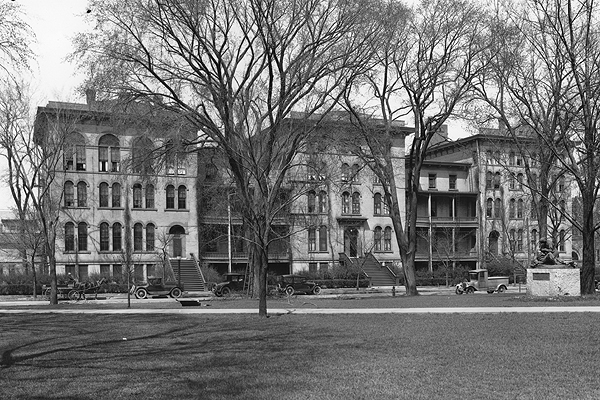 |
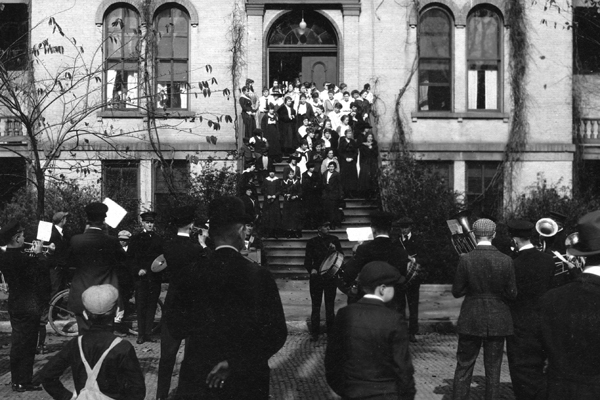 |
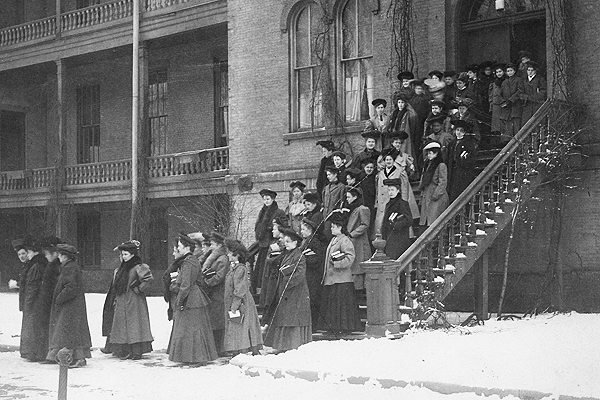 |
|
Whiting Hall Female Seminary in later years (click to viewer larger images) |
||
Grant Forssberg '09
Bibliography
|